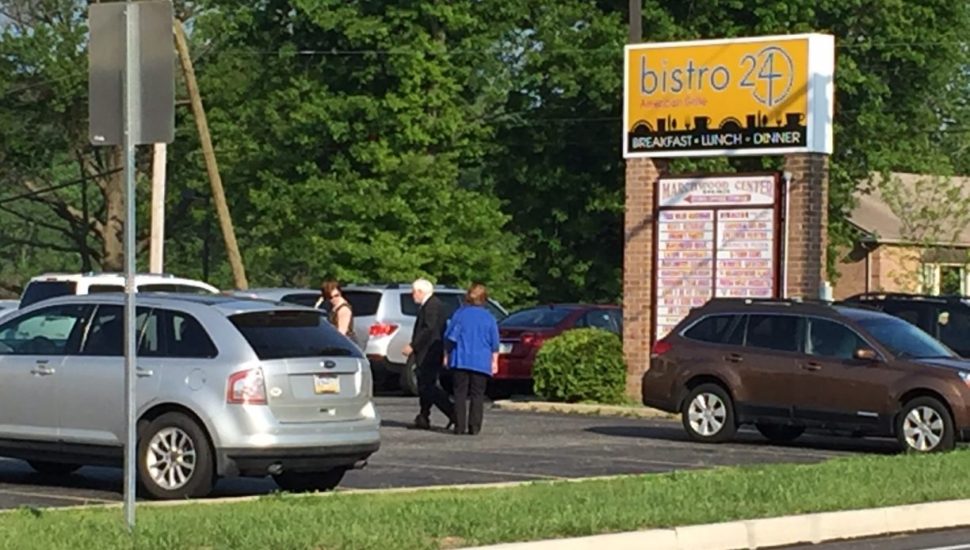Barry Rabin: County Business Signs Are Too SMALL

By Barry Rabin,
Question: What can barely be seen with the naked eye?
Answer: The wording on an increasing number of business signs in Chester County.
There’s been an epidemic in recent years of business signs that are too small to be read by a normal human being while driving down the road
But don’t blame the businesses. The problem is with the increasingly restrictive sign ordinances which have been written into the codes of many local municipalities.
Based on a theory that “smaller is prettier,” these rules severely limit the size of the signs that a business or shopping center can put up.
The “poster child” for unreadable signs is the sign for the Marchwood Shopping Center, located on Route 100 just north of Exton (above). At the top of the sign is a big-enough-to-read sign for “Bistro 24.”
But below that are the microscopically small names of the thirty-odd other businesses located in the center.
Not one of those business names can be read by a motorist driving who is down the highway.
But this is just one example.
The newly-renovated Black Hawk Center in Downingtown – just down the street from my office – features a brand-new sign with the business names printed so small that they can barely be read while driving past it (unless drivers are looking sideways, which is rarely a good idea while driving).
These super-restrictive sign ordinances are depriving Chester County businesses of the ability to let passing motorists know where they are located.
Sadly, the impact of this problem is greatest on small, family-owned businesses. If you’re a big national or regional chain (think McDonald’s or Wawa), your highly-recognizable logo on a small sign will be recognized by approaching motorists long before they can actually read it.
But small, locally-owned businesses (the kind our municipalities should be encouraging and supporting) don’t have that luxury. For them, unreadably small signs are the kiss of death.
But these two-small-to-read signs don’t just pose a business problem. They also create a serious highway safety hazard.
Why? Because as numerous studies show, it takes a driver a certain amount of time after they can read a sign to process what it says and react accordingly behind the wheel. Give them a big enough sign and they’ll have time to read it, put on their turn signal, brake normally and pull into the business.
But if a driver can’t read and process the sign until he or she has almost passed it, the same studies show that that driver is more likely to slam on their brakes suddenly, thus risking a rear-ender by the car behind them. Great for auto body shops, but not for you or me.
Studies by Penn State University and others have demonstrated that as the size of business signs gets smaller, the number of traffic accidents gets larger. This research all supports larger, more readable signs.
The federal government knows this. That’s why the lettering on speed limit and exit signs has gotten bigger and more readable in recent years.
The Federal Highway Administration’s “Manual on Uniform Traffic Control Devices” sets forth specific minimum sizes for traffic signs, based on relevant factors such as distance from traffic lanes and vehicle speed.
In other words, at the same time the federal government has been making signs bigger to be more readable, local governments in our region have been legislating our business signs to be smaller and less unreadable.
I’m not suggesting that any of our municipalities have intentionally tried to hurt small businesses or cause more traffic accidents. But what they have done is to adopt follow-the-leader sign codes that equate smaller with prettier, while losing sight of the critical issue of how well the sign actually functions, and how safe it is for drivers trying to read it.
(Some municipalities even appear to be punishing themselves. I’ve driven past a number of municipal “welcome” signs in Chester County where everything but the name of the locality was too small to read.)
These overly restrictive sign rules have yet another negative effect: They stifle creativity when it comes to the signs that a business can put up.
As a boy growing up in Coatesville, I have fond memories of some of the iconic business signs that were located just over the bridge in Caln Township. These include the Zinn’s Diner (later Ingleside Diner) sign, a large, majestic neon number rising out of a big brick planter, and the Ingleside Bowling Lanes sign, which consisted of a massive bowling ball with an equally huge bowling pin seemingly flying through the air.
As far as I can tell, neither of those magnificent, creative signs would likely be permitted under today’s local sign ordinances.
When was the last time you spotted a really interesting-looking business sign in Chester County?
So what can be done to fix this problem?
Small businesses in Chester County – perhaps through our chambers of commerce – need to band together and start having a conversation with local municipalities about this issue.
And municipal officials in turn need to look at the plentiful research on this subject, talk to some sign readability experts, and then rethink the limits they’ve put on sign sizes.
If everyone works together, I am confident that some kind of balance between form and function can be achieved that would benefit both businesses and residents.
After all, when it comes to signs, size matters.
________
 Barry Rabin is an attorney and writer based in Chester County. He welcomes your comments at rabinwrites@aol.com, or follow him on Twitter @BSRabin.
Barry Rabin is an attorney and writer based in Chester County. He welcomes your comments at rabinwrites@aol.com, or follow him on Twitter @BSRabin.
© 2016 by Barry Rabin.
Connect With Your Community
Subscribe to stay informed!
"*" indicates required fields
























![95000-1023_ACJ_BannerAd[1]](https://vista.today/wp-content/uploads/2023/03/95000-1023_ACJ_BannerAd1.jpg)























